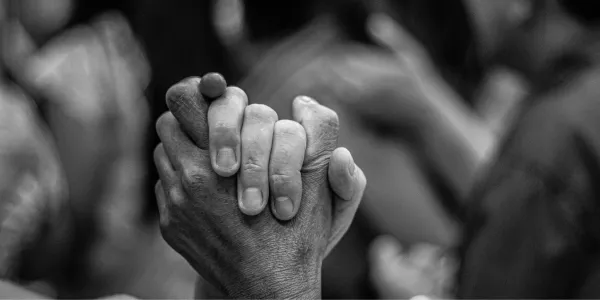Blog

Redefining Peace: Embracing the Richness of Positive Peace
"Positive peace is not just the silence after the guns have been silenced, but the symphony of a people living in harmony."
Redefining Peace: Embracing the Richness of Positive Peace
We've long held the notion that peace is simply the absence of conflict - that if we can just put an end to the fighting, the wars, the violence, then we've achieved peace. This narrow perspective has dominated our collective understanding of what it means to live in a state of harmony. But this view of peace as the cessation of hostilities is akin to believing that health is just the absence of disease. It overlooks the crucial elements that allow societies to truly thrive.
What we need to understand is the concept of "positive peace" - a far richer and more nuanced state of being that goes beyond the mere cessation of direct violence. Positive peace is the presence of the attitudes, institutions and structures that create and sustain peaceful, equitable societies. It is the flourishing of communities, the equitable distribution of resources, the upholding of universal human rights.

Positive peace is not just the silence after the guns have been silenced, but the symphony of a people living in harmony.
Instead of looking at the causes of war, we can explore the attitudes, institutions and structures that build a more peaceful world and strive to create these conditions in all areas. Most cultures explore the concept of peace through various lenses:
-Shanti (Indian; to maintain a tranquil mindset even in suffering or conflict)
-Heiwa (Japanese; aligning oneself to the common good/social order)
-Shalom (Hebrew; right relationships or unity and prosperity, a sense of wholeness arising out of justice)
-Ubuntu (Zulu; self-assurance through linked humanity, one part of a whole)
Through these various cultural perspectives, several dimensions of positive peace emerge:
Systemic and complex: Peace is not a simplistic absence of violence but a multifaceted, interconnected state of being.
Virtuous or vicious: Depending on the underlying conditions, peace can be a positive, uplifting cycle or a negative, destructive one.
Preventative: Positive peace involves addressing root causes and building resilience to avoid the outbreak of conflict.
Underpins resilience and nonviolence: Positive peace creates the foundations for societies to manage tensions peacefully.
Informal and formal: Peace manifests in political and institutional arrangements, social norms, and individual mindsets.
Supports development goals: Positive peace is essential for sustainable, equitable progress and the fulfillment of human potential.
Consider the case of post-conflict Rwanda. In 1994, the country was ravaged by a genocide that left deep scars and bitter divisions. The killings stopped, the fighting ceased - by all measures, Rwanda had achieved "negative peace." But the work was far from over. Rebuilding trust, healing trauma, and creating institutions that served all Rwandans equally were the essential, if daunting, tasks required to forge genuine, lasting peace.
In the years since Rwanda has made remarkable strides in stabilizing the country and cultivating the pillars of positive peace. Its government has invested heavily in inclusive economic development, reducing poverty and inequality. It has prioritized justice and reconciliation, with innovative programs like the Gacaca courts that promoted grassroots accountability. It has also worked to reshape social norms, reframing identity politics and fostering a culture of mutual understanding.
The results have been striking. Where once there was only the brittle silence of an uneasy ceasefire, there is now the vibrant hum of a society that has not just put its violent past behind but is actively building a better future. This is positive peace in action - not the absence of war, but the presence of justice, equity and human flourishing.

This is the lesson we must internalize. Conflict resolution is necessary, but insufficient. We cannot be satisfied with mere "negative peace" - the empty calm after the storm. True, lasting peace requires us to address the root causes of violence, to reconstruct the very foundations of society. It demands that we think not just about cessation, but about creation - the active work of building inclusive institutions, healing divides, and empowering people to live with dignity.
It is an ambitious agenda, to be sure. But the stakes could not be higher. In an era of rising authoritarianism, widening inequality, and the ever-present threat of war, the world needs positive peace more than ever. The path may be long and arduous, but the rewards are incalculable - not just the absence of conflict, but the flourishing of humanity.
The eight key factors, or Pillars, that comprise Positive Peace are:
Well-functioning Government
Sound Business Environment
Equitable Distribution of Resources
Acceptance of the Rights of Others
Good Relations with Neighbours
Free Flow of Information
High Levels of Human Capital
Low Levels of Corruption
Let's examine each of these Pillars in more detail:
Well-functioning Government
A well-functioning government delivers high-quality public and civil services, engenders trust and participation, demonstrates political stability and upholds the rule of law. This Pillar looks at a range of indicators including public service delivery, democratic political culture, transparent laws and policies, control of corruption, and government effectiveness. Countries with strong institutions, political stability, and low levels of corruption tend to be more peaceful.
Sound Business Environment
A vibrant private sector and healthy economy are crucial for peace and prosperity. This Pillar examines factors like the ease of doing business, the strength of the financial system, the level of economic diversification, and the extent of foreign investment. Societies with dynamic, equitable economies that provide meaningful livelihoods are more likely to avoid the desperation and resentment that can fuel conflict.
Equitable Distribution of Resources
Broad-based access to education, healthcare, and other vital services is a hallmark of positive peace. This Pillar looks at measures of income equality, access to basic necessities, and the equitable provision of public goods. When resources are distributed fairly, and all members of society can meet their basic needs, groups are less incentivized to fight over scarce resources or political power.
Acceptance of the Rights of Others
Respect for human rights, tolerance of diversity, and belief in nonviolent conflict resolution are central to positive peace. This Pillar assesses factors like protecting civil liberties, including marginalized groups, and the community's openness to people of different backgrounds. Societies that uphold all citizens' equal rights and dignity are more likely to resolve tensions peacefully.

Good Relations with Neighbors
Cooperative regional and international relationships, low regional tensions, and integration into the global community all contribute to positive peace. This Pillar examines measures of regional integration, diplomatic relations, and participation in international institutions. When countries work together constructively, they are less likely to engage in destructive rivalries or armed conflicts.
Free Flow of Information
Access to information, freedom of expression, and open communication channels are vital for maintaining accountability, exposing corruption, and facilitating the nonviolent resolution of grievances. This Pillar examines factors like press freedoms, internet access, and the flow of information across borders. Societies with robust information-sharing tend to be more stable and resilient.
High Levels of Human Capital
Investments in education, healthcare, and the population's overall wellbeing create the human foundations for positive peace. This Pillar assesses literacy, educational attainment, life expectancy, and workforce skills indicators. When a society nurtures the capacities and potential of its people, it lays the groundwork for long-term stability and development.
Low Levels of Corruption
Transparent, accountable institutions and low levels of bribery and nepotism are essential for building trust in society and government. This Pillar looks at measures of public sector graft, the diversion of public funds, and the strength of auditing and reporting systems. Societies that maintain high standards of integrity and impartiality in public affairs are better positioned to manage conflicts nonviolently.
These eight pillars, drawn from extensive research and empirical analysis, offer a comprehensive framework for understanding and cultivating positive peace. They highlight the multifaceted nature of peace-building, encompassing political, economic, social, and cultural dimensions. By focusing on these key factors, we can move beyond the simplistic notion of peace as the mere absence of war, and work towards the creation of flourishing, equitable societies.
The journey towards positive peace is neither easy nor quick. It requires sustained commitment, innovative thinking, and a willingness to tackle deep-seated challenges. But the potential rewards are immense - not just the cessation of hostilities, but the flourishing of humanity. In an era of growing global uncertainty, the world needs more positive peace than ever. Let us embrace this rich, transformative vision, and set out to build the conditions for lasting peace, justice, and human dignity.
